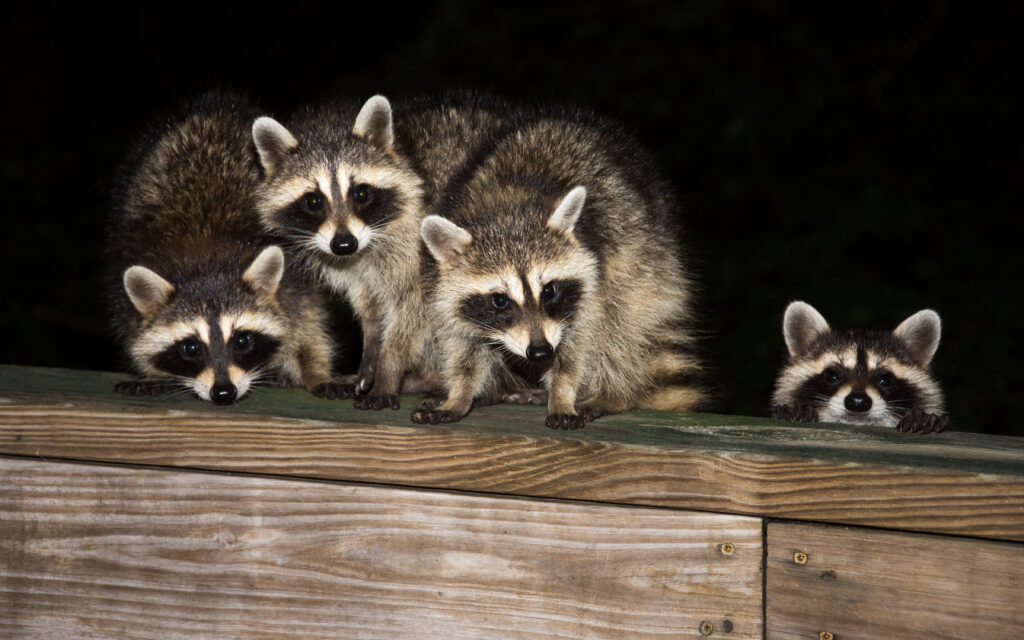Every fall, nights grow longer and trees transform into bare skeletons. The witching hour brings eerie sounds from unknown creatures. But Mecklenburg County Park and Recreation nature centers are dispelling myths about nocturnal species and things that go bump in the night.
What do you know about the county’s native creatures that roam in the dark? Let’s look at four often-misunderstood species spotted at night.
Bats
Did you spot a bat on an early morning or twilight walk? Don’t worry, you won’t find Dracula in his winged form here.

It’s not the animal blood-drinking vampire bat of Mexico and Central and South America. You likely spotted one of the several bat species that make their home in Mecklenburg County. It could be the big big brown bat, the evening bat, the hoary bat, the red bat, the silver-haired bat, the tricolored bat or even the endangered gray bat. Local species feed on insects and agricultural pests. They even spread pollen and seeds for plant reproduction. These traits make them crucial to a healthy ecosystem.
Raccoons

No, that raccoon isn’t wearing a Halloween mask. But it may behave like a bandit. Healthy raccoons are intelligent and adaptable — able to sneak a midnight snack from your garbage.
Often dwelling near water in bottomland forests, hardwood swamps and marshes, raccoons eat fish, insects, berries, nuts, worms, shellfish, birds and eggs. Active at night, they rely on their sense of touch to find food they can’t see. However, it’s possible to see them during the day as well. Urbanized areas like much of Mecklenburg County provide ample food sources for raccoons and few predators. Therefore, to avoid conflicts with raccoons, ensure your yard is free of unnatural food sources and secure your garbage.
Raccoons that are acting sick or are abnormally active during the day may have rabies. Mecklenburg County Public Health has tips for protecting yourself from rabies.
Opossums
The real living dead, this native marsupial inspired the idiom “playing possum.” It defends itself in the face of a predator by flopping over, letting its tongue hang out, and emitting a terrible odor.

But, opossums also hiss and bare their 50(!) teeth when threatened. This behavior, and their unusual appearance — once described as having the head of a pig, the tail of a rat, and the size of a cat with baggage under her belly — has given the species an undue reputation for aggressiveness.
Like bats, the misunderstood, nocturnal opossum benefits the ecosystem by eating pests. It feeds on ticks, cockroaches, snails, slugs, snakes, rats and mice. Additionally, like raccoons, it will make a meal of garbage. So make sure your garbage containers are secure.
Corn Snakes
Finding a corn snake might give you a fright. But this reddish-brown species is nonvenomous and docile, and among the most common snakes in North Carolina.

The nocturnal corn snake will spend its day hiding under logs or dead trees, or in rodent burrows. It’s often found on roads at night. When alarmed, the snake will usually try to escape, but it may strike out if cornered.
Corn snakes are constrictors. They kill their prey — rodents, small mammals, birds and eggs — by squeezing. Corn snake predators include hawks, carnivorous mammals and other snakes.
Bonus: Coyotes
Is that a werewolf howling at the full moon?
You’re not likely to find that mythical animal in Mecklenburg County. Instead, you may be hearing the twilight howls of its smaller cousin, the coyote. Coyotes are crepuscular: active at dawn and dusk. They howl to locate pack members, distract threats away from their dens, and establish territory. Their howls have a hollow tone that makes a pair of coyotes sound like a larger group and seem closer than they are.
Coyotes sometimes prey on domestic pets, but they generally steer clear of humans. They are also a predator of native white-tail deer. In urban and suburban areas like Mecklenburg County, where coyotes are less common, the deer population can grow to unhealthy levels.

